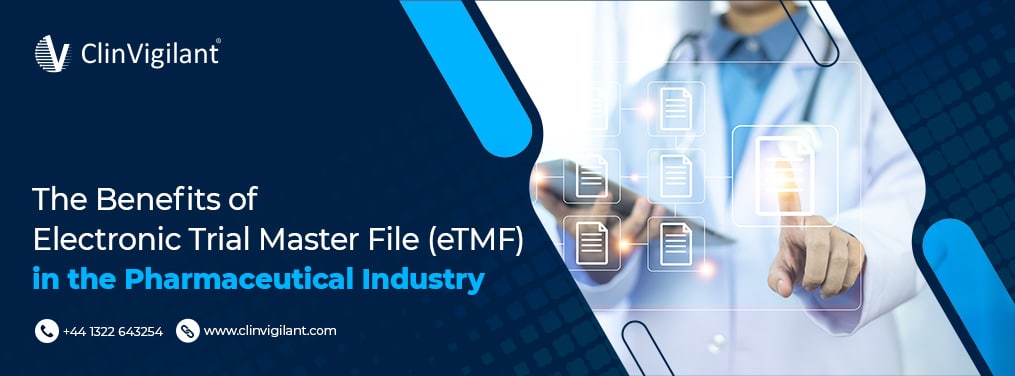
The pharmaceutical industry adheres to strict regulations, and clinical trials play a pivotal role in developing medicinal products. One crucial element in this process is the Trial Master File (TMF), which records and safeguards the integrity of clinical trials. Nonetheless, the traditional paper-based TMF is highly time-consuming, inefficient, and prone to errors, posing significant operational challenges to pharmaceutical companies attempting to manage clinical trials effectively. However, electronic Trial Master File (eTMF) systems have emerged as a game-changer in conducting clinical trials. These systems offer many benefits, including improved efficiency, accuracy, and compliance, all contributing to expedited drug development and better patient health outcomes. This article will explore the various advantages that eTMF has brought to the pharmaceutical industry.
What Is an Electronic Trial Master File (eTMF)?
A digital storage facility known as the Electronic Trial Master File (eTMF) has been devised to catalog and manage the vital documentation produced during the execution of a clinical trial. The eTMF is the principal location of all information about the trial’s blueprint, progress, and outcomes, constituting an essential documentation source.
Previously, trial master files were documented on paper, causing challenges in managing, storing, and retrieving records. However, contemporary eTMF solutions offer a streamlined digital platform for efficient and secure documentation and management of clinical trial records. The eTMF encompasses a range of crucial study-related documents, including study protocols, case report forms (CRFs), investigator brochures, informed consent forms (ICFs), adverse event reports, regulatory correspondence, and other essential records.
Using eTMF yields multiple advantages, including instantaneous access to information, superior document management, and heightened compliance. Moreover, eTMF facilitates seamless collaboration amongst stakeholders involved in the trial, including sponsors, clinical research organizations (CROs), and sites, by enabling efficient sharing and tracking of documents during the trial’s lifecycle. Additionally, the eTMF ensures data quality and integrity by monitoring the completeness, accuracy, and latest updates of all documents.
How eTMF Improves Efficiency and Compliance
Electronic Trial Master Files (eTMF In Clinical Research) improve efficiency and compliance in several ways:
Real-time access to information
With an eTMF, authorized stakeholders can access study documents from anywhere in the world using a computer or mobile device with an internet connection. This facilitates faster decision-making and collaboration without the need to physically locate or send documents.
Improved document management
eTMFs enable standardized document formats and naming conventions, which improves the organization, retrieval, and tracking of study documents. With automated workflows, eTMFs reduce manual document handling and the risk of errors associated with paper-based processes.
Enhanced compliance
eTMFs can support compliance with regulatory requirements, such as 21 CFR Part 11, by providing audit trails, electronic signatures, and data encryption. eTMFs also facilitate inspection readiness by providing a complete and accurate record of study documents, which supports regulatory inspections and audits.
Facilitates collaboration
eTMFs enable seamless sharing and tracking of documents among trial stakeholders, including sponsors, clinical research organizations (CROs), and sites. This improves communication, reduces duplication of efforts, and ensures that all stakeholders have access to the latest study documents.
Improved data quality and integrity
eTMFs enable verification of the completeness and accuracy of study documents. eTMFs also allow sponsors and monitors to detect and resolve data discrepancies quickly, ensuring data quality and integrity throughout the study.
How eTMF Promotes Collaboration Across Teams and With Partners
Electronic Trial Master Files (eTMFs) facilitate collaboration among teams and partners in various ways.
- Centralized access to study documents: they offer a centralized platform for storing and accessing study documents. This centralized access allows stakeholders to access documents in real time from any part of the world, promoting collaboration by eliminating the need for physical document handling. It further enables faster decision-making and facilitates remote communication among stakeholders.
- Effortless document sharing: Electronic Trial Master Files (eTMFs) facilitate the effortless exchange and monitoring of research documents and data among those involved in the study, including sponsors, clinical research organizations (CROs), and trial sites. This enhances communication, minimizes redundant efforts, and grants all parties direct access to the most recent research materials.
- Enhanced communication: eTMFs optimize collaboration among relevant parties by granting immediate access to up-to-date trial documents and data. As a result, stakeholders remain current on performance and progress, work together on addressing problems, and make informed decisions based on the most current information available.
- Standardized document formats: Using eTMFs facilitates the implementation of standardized document formats and naming conventions, effectively enhancing the organization, retrieval, and tracking of study materials. Such a system promotes smooth collaboration across all parties involved by granting them easy access to the same documents, regardless of geographical location.
eTMF Enables Faster Study Start-Up
Yes, electronic Trial Master Files (eTMFs) enable faster study start-up by improving efficiency, collaboration, and compliance during the study start-up process. Here are some ways in which eTMFs can facilitate faster study start-ups:
Centralized document management
eTMFs provide a centralized platform for storing and managing study documents, enabling sponsors and CROs to easily access and share documents with study sites and regulatory authorities. This reduces the time and effort required to locate and distribute study documents during the start-up process.
Standardized document templates
eTMFs enable standardized templates for study start-up documents, such as study protocols, informed consent forms, and investigator brochures. This ensures consistency and completeness of study start-up documents, which can accelerate the review and approval process by regulatory authorities.
Automated workflows
eTMFs enable automated workflows for study start-up processes, such as site selection and initiation, regulatory submissions, and study document tracking. This reduces manual effort and improves the accuracy and completeness of study start-up activities.
Real-time monitoring and tracking
eTMFs enable real-time monitoring and tracking of study start-up activities, which allows sponsors and CROs to quickly identify and address any issues that may arise during the start-up process. This can help to prevent delays and ensure that the study is initiated on time.
Compliance with regulatory requirements
eTMFs support compliance with regulatory requirements, such as 21 CFR Part 11, by providing audit trails, electronic signatures, and data encryption. This ensures that study start-up documents are securely managed and maintained under regulatory requirements, which can accelerate the review and approval process by regulatory authorities.
Consider the following guidelines when implementing an electronic Trial Master File (eTMF) system for pharmaceutical companies:
- Develop a comprehensive eTMF strategy that aligns with the organization’s goals and objectives. This strategy should include a well-rounded plan for implementation, training, ongoing maintenance, and support.
- Verify the accuracy and completeness of all study documents recorded in the eTMF system. Establish clear document management processes and ensure that all team members are trained on these processes to guarantee the precision and clarity of the data.
- To promote the consistency and comprehensiveness of study documents, pharmaceutical companies should adopt standardized document templates for study initiation, execution, and close-out procedures.
- Providing adequate training and support to all personnel involved in utilizing the electronic trial master file (eTMF) system is crucial. This encompasses equipping the team members with skills in document handling protocols, system features, and optimal practices for recording and retrieving data.
- Pharmaceutical companies must prioritize data security and compliance by ensuring their eTMF system adheres to all pertinent regulatory requirements, particularly 21 CFR Part 11. This necessitates executing data security measures, like user access controls and data encryption, and maintaining an exhaustive audit trail of all system activity.
- To guarantee that all tasks and responsibilities are clearly defined and efficiently executed, it is critical to establish unambiguous roles and responsibilities for all team members in managing the eTMF system.
- Regular system audits are crucial in identifying and addressing any issues with the eTMF system, including missing or incomplete documents. Accordingly, pharmaceutical companies must carry out routine audits of their eTMF system to verify that it is functioning as intended and that all study documents are precisely recorded.
Conclusion
Electronic Trial Master File (eTMF) systems have become an indispensable tool for pharmaceutical companies to manage clinical trials more effectively. With numerous benefits, including enhanced efficiency, precision, and compliance, these systems enable faster drug development and improved patient outcomes. eTMF systems offer centralized document management, standardized document templates, automated workflows, and seamless monitoring and tracking of study activities in real time. Additionally, eTMF promotes collaborative efforts among teams and partners, leading to faster study start-up, enhanced data accuracy, and completeness. By implementing eTMF Clinical Trials systems, pharmaceutical companies can optimize clinical trial efficiency, reduce associated costs, speed up drug development timelines, and ultimately bring new treatments to market more expeditiously while improving patient outcomes.

